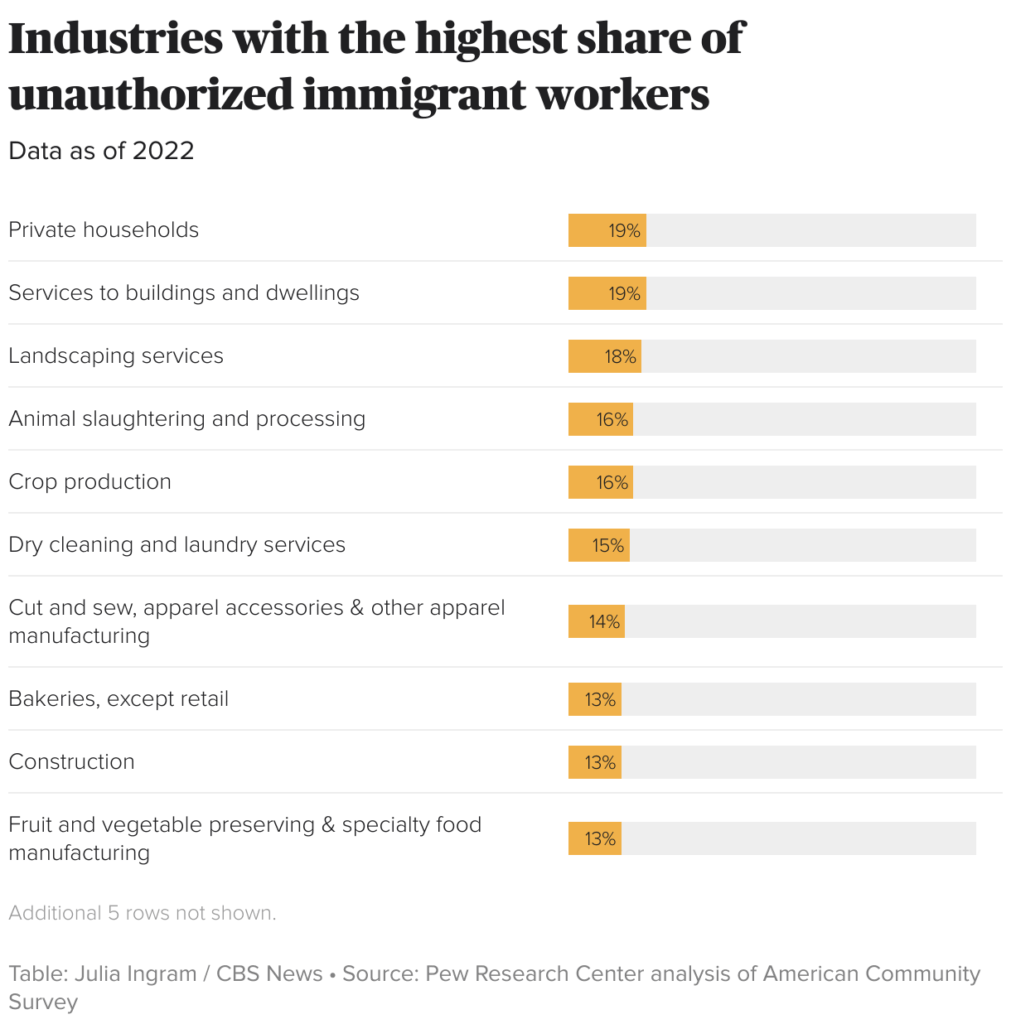If Donald Trump gets his way with immigration enforcement, entire sectors of the U.S. economy could teeter on the edge of collapse. From the lettuce fields of California to bustling hotel kitchens in Texas, industries built on immigrant labor are bracing for a historic squeeze.

Trump’s Immigration Blitz Could Spark an Economic Meltdown
| Insight | Why It Matters |
|---|---|
| Labor-heavy sectors—agriculture, hospitality, construction—face immediate disruption. | Worker shortages lead to stalled production and supply issues. |
| Up to $130 billion hit to GDP possible. | Deportations reduce workforce, spending, and tax revenue. |
| Raids spark panic in business planning. | Flip-flop policies make it impossible to forecast labor needs. |
| Inflation and stalled growth loom. | Less labor, less output, higher prices. |
Trump’s immigration blitz isn’t just about politics—it’s about paychecks, productivity, and the stability of American life. Removing hundreds of thousands of workers might thrill a voter base, but it risks kneecapping industries that keep food on shelves, roofs over heads, and patients cared for.
If policy doesn’t balance border security with economic reality, we might see not just deportations—but a deep, self-inflicted economic wound.
A Perfect Storm in the Fields
Trump’s aggressive new immigration push has reignited fears among farmers and ranchers. Nearly 38% of America’s agricultural labor force is foreign-born, according to the U.S. Department of Agriculture. In places like California and Idaho, that number can climb even higher.
“Without immigrant workers, I’d have to let the fruit rot on the vine,” one Yakima Valley grower told Axios in a recent feature.
During a two-week ICE surge in April, multiple dairies reported losing over half their workforce. In other cases, even legal workers fled, afraid they’d be swept up in surprise inspections. And when workers vanish, prices spike—mirroring the COVID-era food inflation we thought we left behind.
Construction Chaos
Immigrants comprise roughly 25% of U.S. construction labor, per the National Association of Home Builders. Removing them en masse could be catastrophic.
“We’re already short 400,000 workers,” one Texas-based contractor told Investopedia. “If Trump brings back full-scale raids, it’ll put new home builds on ice.”
Without these workers, developers face costly delays and rising wages that get passed down to buyers—especially in high-demand states like Florida, Texas, and Arizona. UCLA’s Anderson Forecast suggests this could amplify existing recession risks.
Restaurants, Hotels, and Retail Feel the Pinch
Hospitality isn’t safe either. Nationwide, 22% of restaurant workers and 31% of housekeeping staff in hotels are immigrants. In Texas alone, ICE raids temporarily shut down five hotels and triggered walkouts at two restaurant chains, according to AP reports.
“When you lose your cooks and housekeepers overnight, there’s no plan B,” said one Austin café owner. “We’re down 40% revenue this month.”
A broader chill has set in. Consumer spending dipped 0.9% in May, and economists say that fear of instability is part of the reason.

The Quiet Toll on Health and Manufacturing
It’s not just food and lodging. Brookings research estimates that deporting 500,000 immigrants could vaporize 870,000 manufacturing jobs through ripple effects. Health care faces a brain drain too, as immigrant nurses and aides—often on temporary visas—face legal limbo.
Long term? GDP could shrink by up to 0.5 percentage points in 2025, equating to a $130 billion loss, according to forecasts reviewed by Wired.
Goldman Sachs adds that inflation might rise 1–9% by 2028 if deportations tighten labor across industries.
Internal GOP Tensions and Business Blowback
Some Republicans have begun voicing concern. Senator John Boozman (R-AR) is calling for streamlined visa options to fill essential roles. Meanwhile, business lobbies are pressing Congress for a legal path to permanent work authorization for immigrant laborers.
Even within the Trump camp, there’s division. Homeland Security Secretary Ken Rollins initially paused enforcement in May after warnings from agriculture leaders—but was overruled weeks later by Trump’s hardliners.
Expert Opinion
I’ve been reporting on immigration and labor since the pandemic, and I’ve seen firsthand how losing essential workers—even for a few weeks—can rattle supply chains and deflate local economies. This isn’t a hypothetical. It’s déjà vu with higher stakes.
Goldman Sachs analysts call the current risk “moderate but rising.” But if Trump enforces mass deportations at the scale proposed, economists warn we could see a 2020-style labor crisis without the stimulus checks.
What Can Be Done?
- Modernize Work Visas
Offer more H-2A and H-2B seasonal visas to legally fill urgent labor gaps. - Protect Key Sectors
Carve out exemptions for agriculture, health care, and infrastructure projects. - Ensure Policy Stability
Businesses need consistency, not weekly reversals, to plan hiring and operations.






